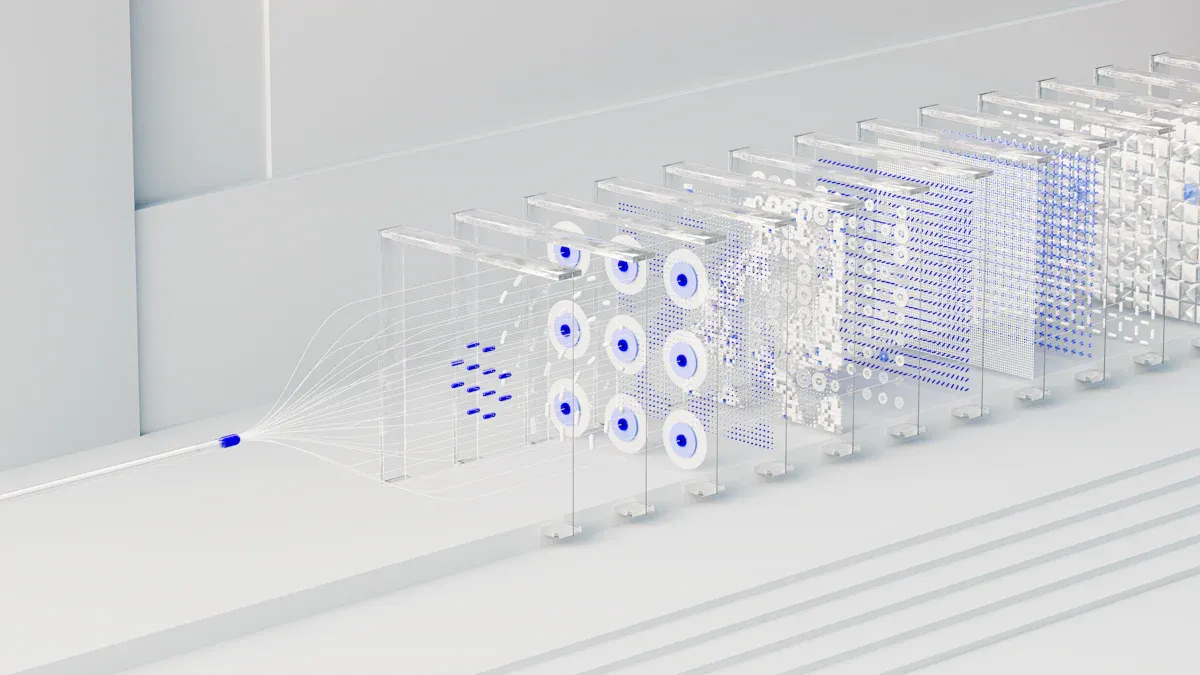The Evolution of AI Stores in Retail from 2010 to 2025

You see retail changing quickly as AI Store technology changes shopping. The retail e-commerce market grew from $550 billion in 2001 to $6.09 trillion by 2024. AI now gives you personal suggestions and does some jobs for people. This makes shopping easier. Stores spend more money on AI. Budgets go up from 15% in 2024 to 20% in 2025. You see better customer experiences and fewer problems with too much stock.
Year | AI Investment (% of Tech Budget) | Conversion Rate Increase (%) | Overstock Reduction (%) |
|---|---|---|---|
2024 | 15% | N/A | N/A |
2025 | 20% | 15% | 18% |
AI-driven product recommendations help customers have a better time.
Generative AI makes marketing content right away.
Key Takeaways
AI Stores help you shop faster and make it feel personal by using smart technology to show products you might like.
When stores use AI, they can guess what people want and avoid having too many extra items. This helps them keep track of their products better.
Generative AI lets stores make ads and posts quickly. This helps customers feel more interested and happy.
More stores now have no cashiers. These unmanned stores let you shop easily and save time and money.
To do well with AI, stores should begin with small steps. They need to teach workers and care about what customers want. They also must keep data safe.
AI Store Basics

What Is an AI Store
You may ask how an AI Store is different from a normal store. An AI Store uses smart tools to make shopping easier for you. These stores use automation and data analysis to do many jobs. Artificial intelligence helps with tasks people used to do. You might see robots putting items on shelves. Sensors watch products. Computers make choices right away.
Here is a table that shows how AI Stores are not the same as regular stores:
Feature | Traditional Retail | AI-Powered Retail |
|---|---|---|
Decision-making | Manual, experience-based | Automated, real-time, data-driven |
Personalization | Generic offers | Hyper-personalized experiences |
Inventory Management | Reactive (post-issue) | Predictive and proactive |
Customer Support | Limited to working hours | Always-on AI support across channels |
You get help faster, better product picks, and fewer empty shelves. AI Stores use smart tools to guess what you want. They try to have it ready for you.
Why AI Stores Matter
AI Stores are important because they change how you shop. They also change how stores work. With AI, stores can give you suggestions just for you. They help you find things fast. For example, Walmart and H&M use AI to guess what people will buy. They use it to manage their supply chains. This means you see more items you like and fewer empty spots.
The future of retail will be smarter. There will be less guessing. Stores will know what you want. Shopping will feel more personal. Stores will look and work in new ways.
Unmanned convenience stores are growing quickly. Here are some important facts:
The unmanned store market could be $32.2 billion by 2030. It may grow over 21% each year.
Robotic convenience stores could reach $2.39 trillion by 2030.
New technology and how people shop help this growth.
AI Stores help stores save money and work better. Smart AI systems can make checkout up to 30% faster. Using renewable energy can lower costs by about 15% in unmanned stores. As more stores use AI, shopping will get quicker, smarter, and easier.
Early Years
2010–2015
In the early 2010s, AI started to show up in stores. Stores used big data analytics to learn what you liked. They watched how you shopped. This helped them give you better product picks and special offers. Retailers also used AI algorithms for predictive analytics. These tools helped stores set prices and manage stock better.
Walmart was a leader in using AI for supply chain and inventory. You got faster restocking and fewer empty shelves. Walmart used AI to guess what people would buy. This helped move products from warehouses to stores faster. AI tools let managers see all inventory in every store. It was easier to spot and fix problems. Warehouse automation cut down on hard work and made things safer. AI models helped with logistics by finding better routes and using different ports to avoid delays.
Shopping felt more personal and faster as stores learned to use data and AI together.
Foundational Tech
The start of the AI Store needed some important technologies. Data management systems helped stores collect and organize lots of information. Big data and predictive analytics helped stores see trends and make smart choices. Machine learning let computers get better by learning from data. Natural language processing helped computers understand and answer your questions. Computer vision let robots and sensors watch products on shelves. Robotic process automation did boring jobs, so stores worked better. The Internet of Things connected devices and sensors, giving stores updates right away.
Stores stopped guessing what you wanted and used data for every choice. Early projects showed that advanced analytics could help stores find new ideas, not just check old ones. Stores like Pier 1 Imports used predictive analytics to make marketing more personal for you. Cloud-based machine learning platforms made it easy for stores to build and use AI models fast.
These technologies helped AI Stores grow later on. You saw that technology made shopping easier and let workers help you more. The early years showed that digital tools could make your shopping better and stores smarter.
Key Milestones
2016–2020
Retail changed a lot from 2016 to 2020. This was when checkout-free stores started. Amazon Go opened in 2016. You could walk in and take what you wanted. You did not have to wait in line. Sensors and cameras watched what you picked up. The store charged your account by itself. This made shopping faster and less stressful.
Stores used AI to manage inventory and guess what you might buy. H&M used AI to make store displays better. They changed layouts based on what people liked. Walmart used AI to look at weather and sales data. This helped them stock the right items for each season. Warby Parker used AI to track sales and trends in stores and online. These changes made shopping smoother for you.
You might wonder how these changes helped stores. Here are some results:
More than 55% of stores got over 10% return from AI projects.
Stores using AI had sales go up by 2.3 times and profits by 2.5 times.
The 200 biggest stores raised profits by 39.4% and revenue by 31.3% in five years. They also cut carbon intensity by 20.9%. These gains came from using predictive and generative AI.
Checkout-free technology changed shopping in many ways:
You did not have to wait in long lines. This saved time and made shopping more fun.
Stores needed fewer cashiers, so costs went down.
Without checkout counters, stores used space better.
Sensors and cameras collected data about what you liked and how you shopped.
Staff could help you more instead of running cash registers.
Shopping felt faster, easier, and more personal.
Case Studies
You can see how stores used AI to fix problems. The table below shows some examples:
Retailer | Implementation Details |
|---|---|
Walmart | Uses AI to guess demand for seasonal products by looking at weather and sales data. |
Warby Parker | Manages inventory in stores and online by studying sales, website visits, and social media trends. |
Smart retail case studies show more ways AI helped stores:
Retailer | Application of Agentic AI | Results/Impact |
|---|---|---|
Walmart | Autonomous inventory management with computer vision and shelf sensors | 30% fewer out-of-stock events in six months |
H&M | AI-driven visual merchandising for better store layouts | 17% bigger basket size and faster layout changes |
Amazon/Shopify | Personalized shopping assistants that learn from your behavior | 25% higher average order values, 19% fewer returns |
Zalando | Dynamic pricing agents that adjust prices in real time | Stayed competitive and protected profit margins |
You may ask how stores planned these changes. Many used technology roadmaps to guide their work. Here are some steps they followed:
Teams tracked progress with Kanban boards and mapped steps with flowcharts.
Real-time workshops and online tools helped everyone work together.
Stores updated plans often to stay flexible.
Feedback from each project helped improve future plans.
Clear links between documents and projects made it easy to see what worked.
These smart methods helped stores move fast and learn from each step. You got better products, quicker service, and shopping that felt made for you. The AI Store became a model for how technology could make retail better.
Growth Phase
2021–2025
AI in retail has grown a lot. Stores use AI everywhere now. Grocery chains and big stores use AI for many jobs. They use it for supply chains, store work, and customer service. Companies do not just use AI to save money. They use it to help their business grow and make shopping better for you.
Here is a table that shows how things changed:
Evidence Description | Key Points |
|---|---|
Transition from pilot projects to enterprise-wide deployments | AI is now a main part of grocery stores. It helps with supply chains, store work, and customer service. |
Maturation of early pilots into enterprise-wide systems | Automation and AI help stores grow, not just save money. |
Importance of proving tangible business value | Stores need to show clear results before using more AI. |
Role of organizational culture in adoption | Teams must learn new ways to work with AI. Change is important for success. |
Stores want to see real results before using more AI. They set clear goals and track progress. Teams work together to learn the new technology. This helps stores move faster and serve you better.
Generative AI
Generative AI has changed how stores make products and do marketing. You get shopping that feels more personal. Stores use AI to come up with new ideas and test them fast. This helps them give you products that fit your style and needs.
Generative AI helps stores make new things and give you more choices.
It makes hard jobs easier, so stores work better.
AI looks at lots of data and does many jobs by itself. This changes how stores work.
Here are the main ways generative AI helps stores:
You get shopping that feels made just for you.
Stores make marketing content faster and more often.
Product design gets better because AI studies trends and feedback.
Unmanned stores have grown a lot in these years. You may have gone to a store with no cashiers or staff. These stores use sensors, cameras, and AI to help you shop. You walk in, take what you want, and leave. The store charges you without waiting in line.
Here is a table that shows how unmanned stores help stores make money:
Economic Impact | Description |
|---|---|
Labor Cost Reduction | Unmanned stores need fewer workers, so stores save money. |
Efficiency Improvement | Automation and real-time data help stores work better. |
Revenue Growth | AI helps stores pick better products and sell more. |
You also see other good things:
AI helps stores learn what you like and how you shop.
Stores say they cut costs by 20% to 31%. This means they make more profit.
AI in unmanned stores gives you a shopping trip that feels special. Stores use your data to show you things you want. This makes you happy and helps stores sell more.
Now, AI Stores are real. They change how you shop, what you buy, and how stores work.
Trends & Future

AI Store Trends
Many new trends are changing how stores use technology. Automation and generative AI help stores do jobs faster. Stores use real-time data to give better service. Predictive analytics help stores know what you want. Visual recognition tools make finding products easier. Dynamic pricing lets stores change prices quickly. Immersive shopping uses AR and VR to make shopping more fun.
Trend | Description |
|---|---|
Generative AI | Used for creating content and automating marketing. |
Real-time Data | Helps personalize your shopping experience. |
Predictive Analytics | Forecasts demand and understands what you like. |
Visual Recognition Tools | Makes product searches easier and faster. |
Dynamic Pricing | Adjusts prices based on market trends. |
Immersive Shopping | Uses AR/VR to make shopping more engaging. |
AI helps stores link online and in-person shopping. You get product ideas based on what you bought before. Stores give you special deals and quick help with chatbots. Inventory and prices stay the same everywhere, so you know what to expect.
Looking Ahead
You will see even more changes in the next ten years. Over 70% of custom orders will use AI to design and deliver products. Generative AI will make searching for items easier. Retailers will use AI to fix bigger problems and make shopping feel special. You will see more virtual assistants and real-time help in stores.
If you want to start an AI Store, try these tips:
Teach your customers about your technology.
Use stories and pictures to connect with people.
Focus on what your customers need most.
Show what makes your store different.
Be open about how you use data and keep it safe.
Share real stories of success.
Established retailers should:
Start with small projects to test new ideas.
Train your staff to use new tools.
Collect feedback and improve your systems.
Track your results and keep updating your plan.
Shopping in the future will be smarter, faster, and more personal. You will have a smooth experience, whether you shop online or in a store.
You have watched AI Stores change how people shop. At first, AI tools helped stores use data to make better choices. Personalization and automation made sales go up. Shopping got easier for everyone. When the pandemic happened, stores used AI to give better service. They also worked faster and more smoothly.
Source | Impact on You |
|---|---|
Vaayu | Chatbots and automated checkout help you shop faster. Shopping is simpler with these tools. |
DataHub Analytics | Personalized offers and smooth store work make you happier. You enjoy shopping more. |
By 2028, agentic AI will do more jobs by itself. You should learn about new AI trends. This will help you get better shopping and smarter stores.
FAQ
What is the main benefit of shopping at an AI Store?
You get a faster and more personal shopping experience. AI helps you find what you want quickly. Stores use smart tools to keep shelves stocked and suggest products you may like.
How do AI Stores keep my data safe?
AI Stores use strong security systems. They protect your information with encryption and regular checks. You can ask how your data gets used. Most stores follow strict privacy rules.
Will AI Stores replace all store workers?
AI Stores use robots and computers for some jobs. You still see people in many stores. Workers help with questions, fix problems, and give personal service. AI helps workers do their jobs better.
Can I use cash in an AI Store?
Some AI Stores let you pay with cash. Many use cards or mobile apps for fast checkout. You should check the payment options before you shop.
See Also
The Future of Retail: Embracing AI-Powered Stores
Essential Insights for Retailers on AI-Driven Corner Stores
Revolutionizing Online Store Management with AI Tools
Modern Retail Benefits from AI-Enhanced Combo Vending Machines
